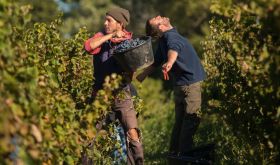Now that I have at long last learnt to love saké, I can report that I am jolly glad that wine is my first love.
The problem with saké, a very similar drink to grape wine in many ways, is that the range of flavours and styles is so narrow relative to its wine equivalent (a bit like the range of flavours in refined Japanese food as opposed to many other cuisines).
Before my second trip to Japan I had encountered saké only as a rather sweaty, fetid warm drink that was fine in a Japanese restaurant but suffered from the twin disadvantages of being stronger than my normal ferment yet requiring rapid consumption on account of its relatively high temperature.
When I saw books and a brochure about its production put out by the Japan saké Brewers Assocation (one of those dubious generic organisations keen to promote its product's infinite superiority, and versatility as a cocktail mixer) I understood where that sweatiness comes from. There were pictures of young Japanese men in their underclothes pounding rice in various stages of fermentation.
The thing about saké, as any producer will tell you, is that it is much more difficult to make than wine. Grapes will ferment more or less as predicted without much intervention, but rice must be treated (polished, so that various proportions – between 20 and almost 80 per cent – of its husk are removed), then saccharified, and only then subjected to complicated mash and fermentation processes with special yeasts and enzymes. The upshot is that saké making is a bit like a cross between making beer and wine.
Fortunately, the results taste much more delicious, more pure and Japanese, than a cross between beer and wine. There is something wonderfully refined about fermented saccharified rice, from which about 65 per cent of the husk has been removed – which takes five days' gentle polishing. (The sweaty stuff I had been exposed to in London was obviously the brown rice, open sandal version.)
These drier sakés, untainted by added alcohol, are called junmaishu and, served cool like most good saké, tend to be the most popular with us westerners, or gaijin as the Japanese call us big-boned, hand-shaking, awkward monsters. The Japanese themselves are in the throes of revolutionary experimentation with everything, even this most ritualistic of Japanese beverages. There are now sakés aged in wood (I tasted one strange creature treated to barrels from Domaine Ramonet of Chassagne Montrachet), sweetened sakés, unpasteurised sakés and sakés aged for up to eight years – which is a mistake to this western palate.
For, unlike wine, saké is a drink to be savoured as young and fresh as possible. In fact, it is made, batch by batch, only in the cool of winter when the yeasts behave most reliably – so the best time to drink saké is in the late winter and spring. By late summer, and in many export markets at any time of year, saké is getting distinctly tired.
I asked my new saké-maker friends about this. The Imanishis are two of the more amazing characters I have met in the drinks business. Father and son, they represent the – hold on for this – 47th and 48th generations of Imanishis who have been supplying their Harushika saké to the Japanese Imperial household, from their base in Nara, birthplace of saké and capital of Japan in the ninth century AD. That was before Kyoto was Japan's capital, and long before upstart Tokyo snatched the crown. I can think of wine dynasties, an unfortunate word perhaps, which stretch back over nearly 30 generations, but I'm afraid on the succession issue we grapies must concede seniority to the ricies.
My Imanishi friends, however, conceded that it took a grapey or two to show them just how important the rice itself might be. Japan, like its European soulmate Switzerland, goes to elaborate lengths to ensure a longterm future for its picturesque farmers, no matter how meagre a living they may scratch relative to its bureaucrats. This means that the saké makers have to buy rather than grow rice (unlike their counterparts in the wine business). Imanishi Senior and Junior went to France and Germany 15 years back to compare notes with fermenters of the grape, and the thing that struck them most forcibly was all the attention the winemakers paid to their raw material. They came back to Japan determined to demand more of their rice suppliers, with happy results.
The Imanishis received us in their 500-year-old family house which is what the Japanese call, using these words, a 'National Treasure'. This involved sitting on tatami mats, being served exquisite-looking tea with sweet bean curd and syrupy slime, adorned with flowers, overlooking an ornamental garden of stone and moss. Imanishi the Younger fielded our questions and his incoming calls, cross-legged, in an Armani suit with silver mobile phone in his breast pocket.
The variables in saké making, quite apart from these new twists in production methods, are provenance of rice, hardness of local water (semi-hard water is best apparently), the variety of rice (which differs from those varieties that are best for eating), how polished the rice is, and whether extra alcohol is added. But tasting saké suggests that all those production frills interpose themselves more obviously between raw material and ferment than ever happens with wine. In fact, learning about saké showed me just how wonderfully transparent the winemaking process is.
For more information and sales of fresh saké to some markets, see www.esake.com, a Japanese site in English. The Imanishis export their saké to Okanaga Europe in Paris 75001 and Harro Foods of London, SW19.













